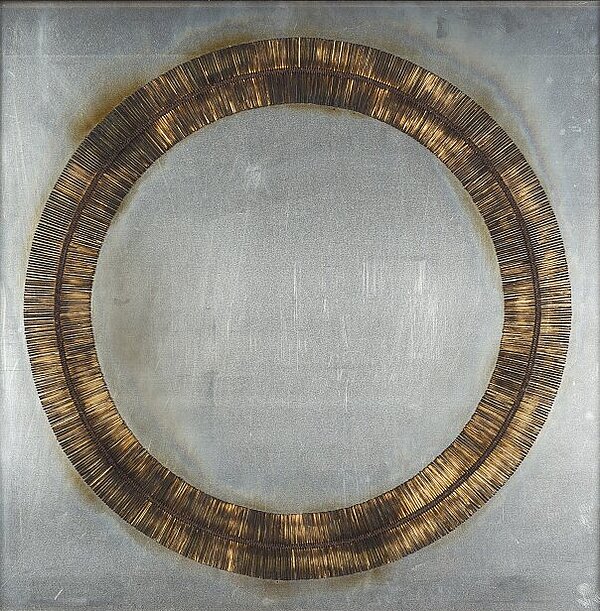Bernard Aubertin
Dessin de feu, 1974
[Fire Drawing]
Matches on metal
90 x 90 cm
© Artist
Photo: Gerhard Sauer
A meeting with Yves Klein in Paris in 1957 became a game-changing moment that was to alter the course of Bernard Aubertin’s artistic career. The art and mental universe presented by “Yves le Monochrome”, as Klein was known to his colleagues, left a lasting impression, above all as a result of his intensive blue paintings and experiments with fire, but also his vision of employing art to make immateriality amenable to perception. Already the following year Aubertin painted his first red pictures, whose monochrome surfaces he structured with spatulas, fork prongs and other implements in an all-over procedure. The colour red was to distinguish his entire œuvre from then on. From the outset he adhered to the principle of teasing out the sculptural potential of paint and the specific modes in which it can manifest. Aubertin’s interest in the implications of the colour red – in terms both of its symbolism and its energy – led him to work with other materials and media. With this his painting soon came to be accompanied by objects and actions which, backed up by Aubertin’s theorising, tackled a wide range of topics including fire, warmth, love and vital energy. On the strength of these works and on Yves Klein’s recommendation, Aubertin entered the circle of the Düsseldorf ZERO movement, and regularly exhibited with the ZERO artists from 1961 onward.
Dessin de feu [Fire Drawing] derives sustenance from the repertoire of motifs and artistic strategies that Aubertin encountered in his exchanges with the avant-gardes of the early sixties. Mounted on a metal plate is a double ring of tightly packed matches that bears witness to a controlled burning action that the artist conducted. With the circle, Aubertin chose a motif much loved by ZERO artists, for it proclaims zero hour and a radical new beginning in art. Simultaneously the simple composition recalls the leaflet Zero der neue Idealismus [Zero the New Idealism] (1963), which set out the movement’s intellectual cosmos on a large circular disc and associated ZERO with among other things fire, smoke, and the sun. The circular shape systematically formed in Dessin de feu using an everyday material, together with the contrast between the cool metal and the charred remains, reveal moreover Aubertin’s programmatic quest for objectivity and realism in his art. Simultaneously the visible traces of the creative process lend expression to the evanescence and transiency of life. (Hsiaosung Kok)
Bernard Aubertin
1934 born in Fontenay-aux-Roses (FR)
2015 died in Reutlingen (DE)


